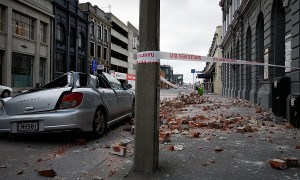

As families of the 185 people killed in the Christchurch earthquake marked the one-year anniversary of the disaster Wednesday, signs of a city still broken were all around them.
Hundreds of wrecked buildings downtown are still waiting to be torn down so reconstruction can begin in earnest – many of them within sight of the morning ceremony at Latimer Square.
The slow pace of recovery is drawing criticism from residents and developers as it wears at the reputation of Mayor Bob Parker, who was praised in the days following the quake for his leadership and for calmly articulating the pain and frustration many were feeling.
“There are many unknowns, there are questions still to be answered, suburbs to be rebuilt and a city to be rebuilt,” Parker said at a larger ceremony later Wednesday in the city’s North Hagley Park. “We’ve had our differences, creative and otherwise. But that is not who we really are.”
Wednesday was a day of reflection amid what has become a battle between city leaders and many Christchurch residents and developers.
More than 10,000 people stood in silence, some in tears, at the park while police officers and firefighters read out the full list of victims. That was followed by two minutes of silence at 12:51 p.m., the minute the magnitude-6.1 quake struck.
The earthquake destroyed thousands of homes and other buildings, causing 30 billion dollars ($25 billion) in damage by the government’s estimate.
Downtown is still a wasteland. About 1,400 buildings there were irreparably damaged, and many still stand. Basic downtown infrastructure like the sewerage system has not yet been repaired, and vital decisions about where to locate major structures in a new-look city – including a proposed sports stadium, library and conference center – remain incomplete.
Many now question whether Parker and council members have what it takes to lead the city through the rebuild.
“The council is seen as being at war with the community and with businesses,” said Hugh Pavletich, a developer and city critic. “It’s an old culture which is bureaucratized and which is severely impeding progress.”
To be sure, ongoing aftershocks and balking insurers also have held back the rebuild. But the political infighting hasn’t helped.
New Zealand’s government recently appointed an observer to oversee what it describes as the “dysfunctional” council. Gerry Brownlee, the government’s earthquake recovery minister, recently called Parker a “clown,” a comment he later retracted. Earlier this month, several thousand Christchurch residents took to the streets, demanding that the mayor, council members and senior officials resign.
Parker and council members unveiled a draft downtown plan last August. It included terraced housing and a new light rail system. Critics said it was stuffed with unrealistic pet projects and didn’t allow developers enough freedom. Brownlee is considering a pared-back version of the plan and is expected to release his own vision soon.
Parker says the city considered more than 100,000 submissions for the plan and that critics form a vocal minority.
Christchurch developer Angus McFarlane said he now expects the commercial core of the city will take 10 years to rebuild and will contain just 30 percent of the retail and office space it did before the quake. He said he’s unsure whether he will reinvest in the city.
He said adaptations made by many businesses after the earthquake – such as working remotely and turning to smaller spaces – will make them unwilling to return to a high-cost city center.
“A lot of people are waking up and saying, ‘Gee, this is marvelous, we should have done this years ago,”‘ McFarlane said.
Parker said the city center will be more condensed than it was before and won’t have the tall office buildings it once did. But he said it will be more dynamic, livable and green.
“You’re not going to satisfy everybody,” he said.
Despite the concerns, residents and businesses have so far remained in the city in numbers that have surprised many. When Statistics New Zealand measured the population of Christchurch four months after the earthquake, it found the population had declined by just 2.4 percent, to 368,000, despite the loss of more than 5,000 homes.
Peter Townsend, the chief executive of the Canterbury Employers’ Chamber of Commerce, said that business receipts continue to come in at more than 95 percent of the level recorded before the quake.
Some parts of the city that have picked up the slack are now booming.
“Business has been remarkably resilient,” Townsend said.
However, he said people need to start thinking about downtown Christchurch in a new way.
“There’s still a perception that we are going to rebuild it much like it was,” he said. “It’s completely untrue.”
Instead, Townsend said he envisions the creation of seven or eight small retail hubs, or villages, around major structures like the hospital and the convention center.
Brownlee, the earthquake minister, said he understands people’s frustration at the pace of the rebuild but added that they need to remember that the earthquake was a massively disruptive event. He said it’s more important to get things right than to rush, and that reconstruction remains on track despite the city’s political problems.
Brownlee said it’s important for land prices to fall in the city to encourage new investment. Overall, he said, he has high hopes for a revamped downtown.
“I feel it will be quite new, quite clean, quite shiny, and safe,” he said. “People say it’s going to be a smaller city, but I’m not convinced. It’s certainly going to be in a tighter area, and it’s going to be integrated a lot better.”
Asked when downtown might be ready for business, Brownlee said he simply cannot predict.